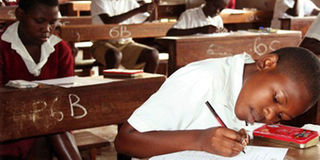Close information gaps with age appropriate sexuality education

What you need to know:
The age-old debate on whether to have sex education in schools never ends. Regardless of what your take is, it is undeniable that information gaps are a source of evil and must be closed.
The fear of the unknown blocking introduction of sexuality education in some schools is, at best, unfounded, owing to the fact that even the traditional African society had an elaborate way of passing on the same information.
The traditional set-up ensured continuous education with different people tasked with the role at various phases of life, from childhood to adulthood. Mother, father, aunts, uncles, grandparents and community leaders all had a role to play.
Transfer gap
There were no gaps: All aspects of physical changes and biology, rights and responsibility at certain ages and, lastly, reparations for engaging in an activity which the society deemed unfit were catered for.
Girls were taught by their aunts and boys by uncles throughout their childhood with the climax being during the rite of passage, such as circumcision.
However, with modernisation and advancement in the formal education, this well-knit structure has been overtaken by events.
Unfortunately, the deliberate and structured sexuality information sharing and transfer gap is increasing. No wonder we struggle with teenage pregnancies, increasing sexually transmitted infections among youth aged 15 to 24 and a lot of misperceptions and information on the subject.
There’s a gap and sexuality education is the solution to it. It’s said that knowledge is power. But without sexuality education in the curriculum, our children are deprived of this power.
Unesco defines comprehensive sexuality education as a curriculum-based programme of teaching pupils the cognitive, emotional, physical and social aspects of sexuality.
It aims at equipping pupils at different ages with knowledge in regard to their health, biological, physical and legal environment and emotional well-being, hence instilling skills, value sets and attitudes in a religious, family or even school setting.
Content-specific
The arguments in the discussion about the topic — be it by civil society, religious leaders and other players — always seem to be similar, albeit made from different points of view.
And the one point all agree on is the need for the students to be informed, the contention on content notwithstanding.
To say that religious leaders are strongly against sex education, for example, does not make sense because there are structured programmes in Christian settings, which handle sex education in depth. For instance, Ropes (Rights of Passage Experiences) is a yearlong programme to prepare children of ages 13-14 for the transition to adulthood. Others include holiday youth camps, seminars and conferences.
If churches are implementing sex education, why are the clergy against the same being done within the school setting?
It’s time we got age-appropriate and content-specific sexuality education. This can be a structured subject like mathematics or English language, which start from a very basic simplified level to advancement as the learners grow and advance from one class to the next.
The material targeting six-year-olds should not be the same as that for 16-year-old youth. It can also go throughout the formative formal education system — primary and secondary level.
Parents’ role
Secondly, parents need to understand what will be taught since they play a major role in the lives of children in the aspects of information, value system and culture. Children believe what their parents tell them and will, in most cases, ask the adults for clarification
The faith sector plays a big role in people’s beliefs. Hence, their opinion is crucial in children’s formative stages. The more content is passed in the structured youth and children ministries as in school, the more strongly will it be instilled.
Teachers will need to lay emphasis in the subject, which would be in the timetable, and students will be keen to learn, revise and understand it.
Lastly, there is a need to put the student at the centre of the views, discussions, deliberations, endorsement and decisions around sexuality education.
Adapted from Daily Nation


